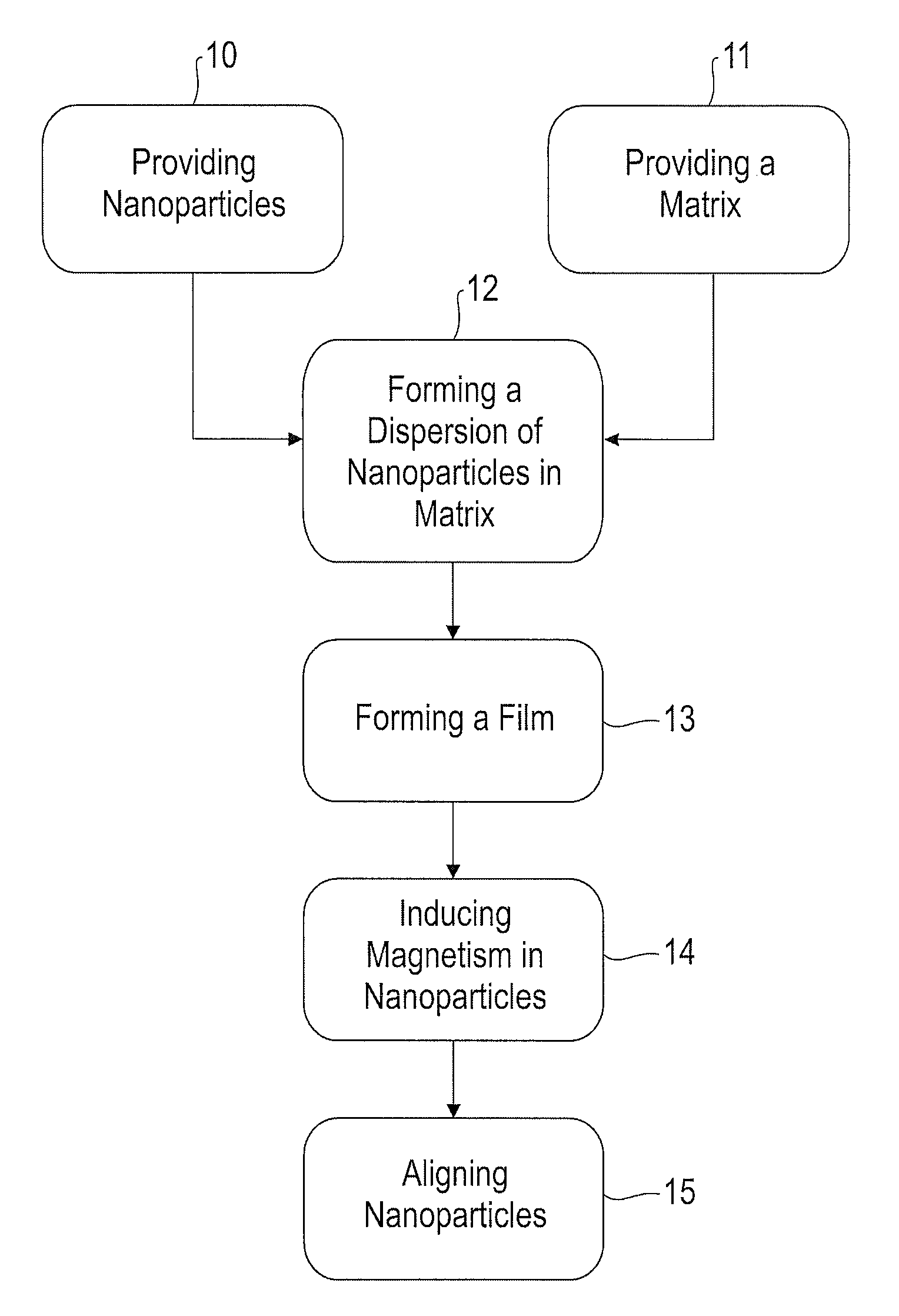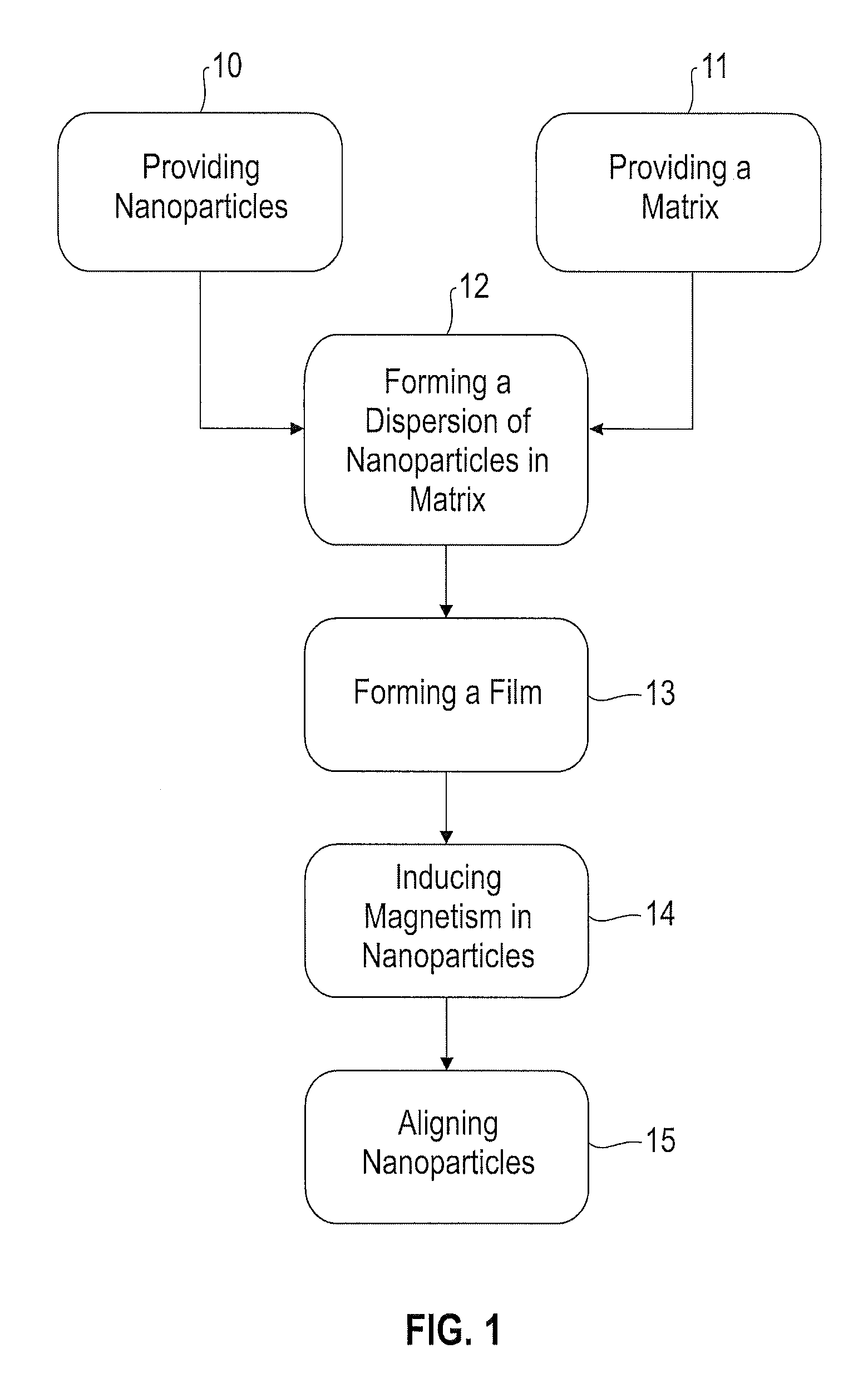Method for forming and aligning chemically mediated dispersion of magnetic nanoparticles in a polymer
a technology of magnetic nanoparticles and polymer matrix, which is applied in the direction of electric/magnetic/electromagnetic heating, magnetic bodies, instruments, etc., can solve the problems of uneven distribution of such ferromagnetic nanoparticles within the polymer matrix, and achieve the effect of enhancing ferromagnetism
- Summary
- Abstract
- Description
- Claims
- Application Information
AI Technical Summary
Benefits of technology
Problems solved by technology
Method used
Image
Examples
example 1
[0040]A 50 ml three-neck round bottom flask fitted with a nitrogen inlet, overhead stirrer, and a Dean Stark trap, was charged with one equivalent (1 g, 4.4 millimoles (mmol)) of III (2,2-bis(4-hydroxyphenyl)propane) and one equivalent of a mixture of I (4,4′-difluorobenzophenone) (0.8728 g, 4.0 mmol) (90%) and the 5-aminouracil ketimine V (0.144 g, 0.44 mmol) (10%). Twelve milliliters (ml) of N,N-Dimethylformamide (DMF) were added, followed by finely ground potassium carbonate (5.0 g) and toluene (20 ml). The reaction was stirred and heated to 140° C. for 24 hours, after which the toluene in the Dean Stark trap was collected and the temperature was increased to 160° C. for about 24 hours. The mixture became extremely viscous, was dissolved in tetrahydrofuran and precipitated from methanol (500 ml) to give a pale brown brittle solid (1.28 g).
[0041]The difluoro ketimine II may be synthesized by the following generalized reaction:
[0042]
example 2
[0043]In one embodiment of the present invention, a difluoro ketimine monomer may be synthesized according to the above equation, where
[0044]
A 250 ml three-neck round bottom flask was charged with 4.36 g (0.02 mole (mol)) of 4,4′-difluorobenzophenone and five equivalents of 1,4-phenylenediamine (10.81 g, 0.1 mmol). The reactants were stirred in p-xylene (120 ml) and a catalytic amount of p-toluene sulfonic acid (0.20 g, 5% weight / weight) was added to the solution. The flask was fitted with a nitrogen inlet and a Dean Stark apparatus and the reaction mixture was allowed to stir at 140° C. for about 24 hours. Thereafter, the dark brown solution was allowed to cool to room temperature and the solvent was removed in vacuo. The product was separated from the excess 1,4-phenylenediamine starting material by running the crude reaction mixture through a silica gel column using ethyl acetate / hexane. Fractions containing the pure difluoro ketimine product were dried in vacuo to give a vivid y...
example 3
[0045]In one embodiment of the present invention, the monomer N-(5-uracil-yl)-4,4′-difluorobenzophenone imine IX may be synthesized according to the following reaction:
[0046]
[0047]To a round bottom flask equipped with an overhead stirrer, 1.16 grams (0.009 mol) of 5-aminouracil was charged along with 6 grams (0.027 mol) of 4,4′-difluorobenzophenone and washed in with a 50 / 50 (volume / volume) n-methylpyrrolidone / n-cyclohexylpyrrolidone solvent mixture and heated to 180° C. for about 3 days. The mixture was isolated in hexane and recrystallized twice from isopropanol. The product was rinsed with isopropanol, suction dried, and vacuum dried in an oven overnight.
PUM
| Property | Measurement | Unit |
|---|---|---|
| temperature | aaaaa | aaaaa |
| temperature | aaaaa | aaaaa |
| thickness | aaaaa | aaaaa |
Abstract
Description
Claims
Application Information
 Login to View More
Login to View More - R&D
- Intellectual Property
- Life Sciences
- Materials
- Tech Scout
- Unparalleled Data Quality
- Higher Quality Content
- 60% Fewer Hallucinations
Browse by: Latest US Patents, China's latest patents, Technical Efficacy Thesaurus, Application Domain, Technology Topic, Popular Technical Reports.
© 2025 PatSnap. All rights reserved.Legal|Privacy policy|Modern Slavery Act Transparency Statement|Sitemap|About US| Contact US: help@patsnap.com



